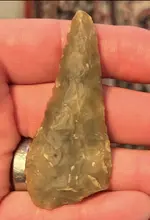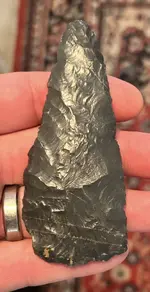I found this large 5.25 inch cobbs April 1991 in southeastern Indiana. Darrell and I were hunting a field and I was cutting across the trough between two hill crest when I spotted the base of this sticking out about 2 inches of the ground, straight up. I called him over and he pulled the blade out, it making a slurping pop as it came out of the wet mud. I think this is made of heat-treated Burlington chert.
I brought it home and Darrell and I were sitting around the table talking and looking at the days finds. I noticed a crack in the edge of the blade, put my finger nail on it and the chip popped out. See location below. Dang.
View attachment 2166525






